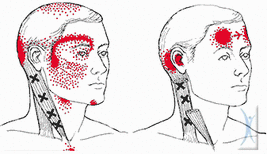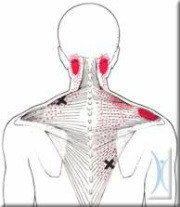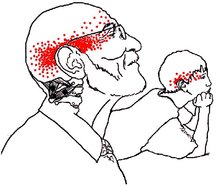
There are a lot of types of headaches, including migraines, cluster headaches, tension headaches, headaches caused by an infection or virus or other medical causes.
In my clinic, if you present with a headache, I will ask you questions to rule out any causes apart from tension. These questions will ask things like:
Most commonly, I see headaches caused by tension in the neck and/or shoulders which causes pain to refer into the head. It's often simply a matter of releasing these muscles by gentle massage, compression, stretching and calming strokes to the neck and shoulders. Often I will target specific muscles, based on the location of you pain. This is often referred to as trigger point therapy, where I will identify a referral pattern, seek out the trigger point that causes it, then activate the trigger point until it calms down and releases. The results are usually pretty instant, and the feedback I get is very appreciative!
The common trigger points I treat are in the SCM (sternocleidomastoid is such a mouthful!), the trapezius and the occipitals and sub occipitals. Check out the diagrams below to see what I mean about a few of these.
In my clinic, if you present with a headache, I will ask you questions to rule out any causes apart from tension. These questions will ask things like:
- Where does your headache hurt?
- When and how often do you get them, and what do you associate with your headache?
- Are you under a lot of stress at the moment?
- Have you been feeling unwell?
- Are there any other symptoms or sensations that you are experiencing?
- Have you been doing any repetitive activities lately, if so what?
- Are you sleeping well, or have you changed the way or position in which you sleep?
- What helps or aggravates your headache?
- Do you take pain relief, and is it effective?
Most commonly, I see headaches caused by tension in the neck and/or shoulders which causes pain to refer into the head. It's often simply a matter of releasing these muscles by gentle massage, compression, stretching and calming strokes to the neck and shoulders. Often I will target specific muscles, based on the location of you pain. This is often referred to as trigger point therapy, where I will identify a referral pattern, seek out the trigger point that causes it, then activate the trigger point until it calms down and releases. The results are usually pretty instant, and the feedback I get is very appreciative!
The common trigger points I treat are in the SCM (sternocleidomastoid is such a mouthful!), the trapezius and the occipitals and sub occipitals. Check out the diagrams below to see what I mean about a few of these.

SCM's are commonly put under pressure when we are in a head forward posture; such as when we are driving, sitting and squinting at a computer screen or sleeping on a pillow that's too high. The red shaded areas show where the pain may refer to.
As it attaches into the top of the sternum, this muscle is also associated with shallow or chest breathing, which we tend to do more when we are anxious or stressed.

The traps refers to one large kite-shaped muscle called trapezius that extends from the spine from near the bottom of the ribcage up to the base of the neck, and out to the edge of the shoulders. It has many actions, depending on which portion on the muscle is activated. In terms of headaches, it's usually the upper portion that pulls the shoulders up toward the ears where the headache causing trigger point is located, such as when we are hunching our shoulders against the cold, or carrying a heavy bag.

Trigger points in the occipitals and suboccipitals at that base of the neck and back of the head cause headaches in the side of the head. They get squashed up when we have our head looking upwards. This often goes hand in hand with the head forward posture typical of SCM's headaches, as in order to look level at the horizon, a forward head then has to look upwards in order to not be looking at the toes! (The SCM's are also under strain in this position, so you often get the double whammy!
In conjunction with treating these muscles, I will also try to suggest some small lifestyle adjustments you can make to prevent the headaches recurring. This may include breathing or relaxation exercises, looking at your carseat position or work station set up, stretches and exercises to strengthen the neck to support your head.
So with this information, you should be a pill popper no more – my own flatmate has always used ibuprofen for her regular tension headaches, but has been very pleasantly surprised how quickly and effectively some gentle massage techniques can offer her far better relief than the pills can!
So what can you do?
You probably need to strengthen your core abdominal muscles (not your 6 pack!), and your neck muscles, which isn't too difficult, in fact I can show you how!
Checking in with an osteopath or chiropractor for a spinal check may also be a good place to start, along with a few massages to release tension and trigger points causing pain. Feel free to give me a call on 833 6162 to discuss your options.
So with this information, you should be a pill popper no more – my own flatmate has always used ibuprofen for her regular tension headaches, but has been very pleasantly surprised how quickly and effectively some gentle massage techniques can offer her far better relief than the pills can!
So what can you do?
You probably need to strengthen your core abdominal muscles (not your 6 pack!), and your neck muscles, which isn't too difficult, in fact I can show you how!
Checking in with an osteopath or chiropractor for a spinal check may also be a good place to start, along with a few massages to release tension and trigger points causing pain. Feel free to give me a call on 833 6162 to discuss your options.

 RSS Feed
RSS Feed
